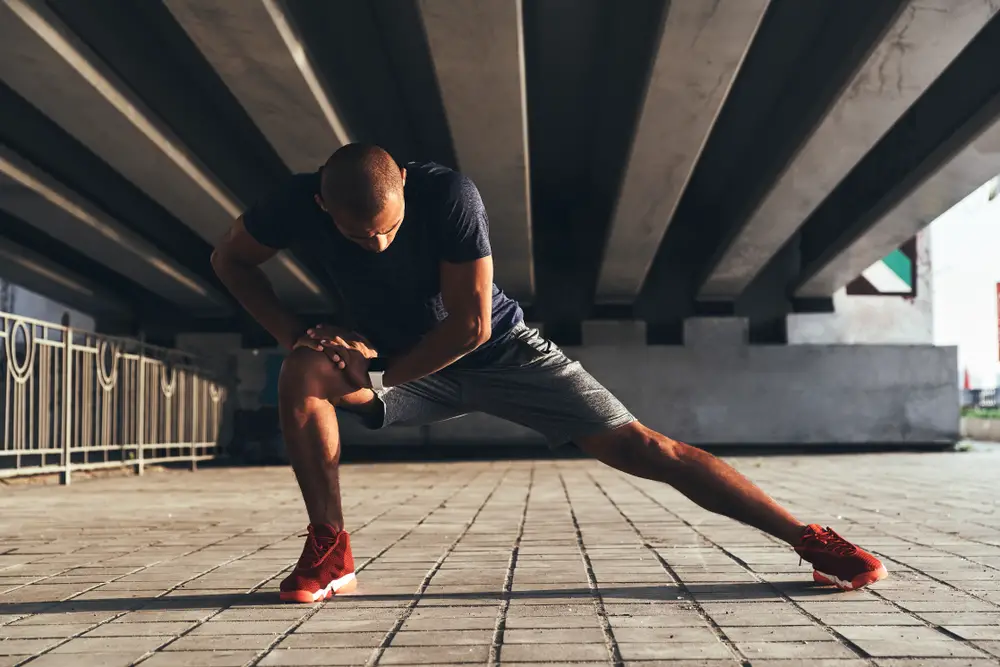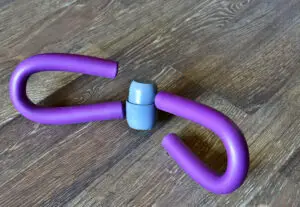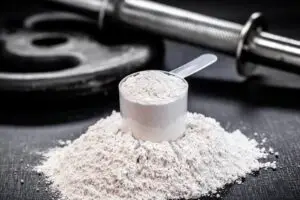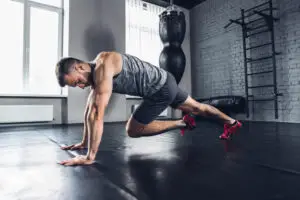Stretches before squats are essential for achieving optimal performance and preventing injuries during your workout. Squats, being a compound exercise, involve multiple muscle groups such as the quadriceps, hamstrings, glutes, hip flexors, and calves. Therefore, it is important to perform stretches that target these muscles to ensure a comfortable and effective squatting session.
Incorporating stretches before squats not only improves your flexibility, but it also increases blood flow to the muscles, resulting in a better range of motion. This can lead to improved squat form, which allows you to maximise the benefits of the exercise and reduce the risk of injury. Additionally, stretching can also contribute to better muscle recovery after your workout, reducing soreness and improving overall mobility.
Some popular and effective stretches to include in your warm-up routine before squatting are ankle rocks, leg swings, plantar fascia stretches, and hip flexor stretches. These movements will help loosen up your muscles, improve your ankle and hip mobility and enhance your overall squat performance.
Understanding Squats
Squats are a fundamental exercise in strength training and fitness, targeting various muscle groups including the glutes, quadriceps, and hamstrings. Proper form and technique play a crucial role in ensuring the safety and effectiveness of squats, allowing for optimal muscle activation and injury prevention.
There are several squat variations that cater to different fitness levels and goals. For beginners, bodyweight squats are an excellent starting point, as they focus on mastering the basic movement without the added pressure of external resistance. As one progresses in their fitness journey, incorporating weights such as barbells and dumbbells can increase the challenge and further develop strength.
A key aspect of performing squats is maintaining correct form throughout the movement. When performing a full squat, the individual should keep their feet shoulder-width apart, while their toes point slightly outward. As they descend, the hips should move back and down, maintaining a neutral spine and keeping the chest up. The knees should track over the toes without caving inwards, and the squat depth should aim for at least parallel to the floor or lower, depending on individual flexibility and mobility.
In weighted squat variations, particular attention should be given to the position and balance of the bar’s weight. For instance, in a back squat, the barbell should sit across the upper back and shoulder area, with the elbows pointing down and slightly back. This positioning ensures even weight distribution across the upper body, aiding in maintaining proper form and preventing undue stress on the spine.
It is vital to practice and perfect squat technique before increasing the intensity or complexity of the exercise. Consistent practice helps in building muscle memory and facilitating proper execution, leading to a stronger foundation for more advanced variations and increased weight capacity. Remember, a confident, knowledgeable, and neutral approach to squats allows for clear understanding and effective progress in one’s fitness journey.
Importance of Stretching Before Squats
It is essential to perform proper stretching before squats as doing so improves range of motion, prevents injuries and maximises performance. There are several types of stretching exercises that can contribute to these benefits, including dynamic stretches, static stretches, and mobility exercises.
Dynamic stretching is an effective way to prepare the body for squatting as it involves active, controlled movements that increase blood flow, warm-up the muscles, and enhance flexibility. Examples of dynamic stretches for squats include leg swings, high knee marches and lateral lunges. Introducing these exercises enhances performance and reduces the risk of soreness or injury during the squat workout.
On the other hand, static stretches entail holding a specific position for a set time, allowing the muscles to lengthen and relax. Although less effective than dynamic stretching for a warm-up, incorporating static stretches helps enhance flexibility and reduce post-workout soreness. Key static stretches for squat preparation include the deep squat hold, kneeling hip flexor stretch, and the pigeon pose.
To further increase the benefits of stretching before squats, athletes should incorporate mobility exercises that target specific joints and muscles involved in squatting. These exercises improve movement quality and joint range of motion, resulting in a more effective and safer squat workout. Ankle mobility drills, hip openers, and thoracic spine rotations are prime examples of targeted mobility exercises for squat preparation.
In summary, incorporating a combination of dynamic stretches, static stretches, and mobility exercises before squatting can significantly boost performance, reduce injury risk, and minimise post-workout soreness. Maintaining a consistent stretching and mobility routine ensures optimal results in squat training and overall fitness.
Muscles Involved in Squats
Squats are a highly effective exercise that target multiple muscle groups. In this section, we will discuss the primary muscles involved in performing a squat and their role in the movement, to help you better understand the benefits of incorporating squats into your exercise regimen.
The quadriceps are the main muscles at work during a squat. These are the four muscles at the front of your thighs, responsible for extending your knees. As you lower into the squat, your quadriceps contract to control the descent, and when you push back up, they engage to straighten your legs.
Your hamstrings, located at the back of your thighs, work alongside the quadriceps to stabilise your knees throughout the squat motion. They also help you maintain balance and control during the ascent and descent of the movement.
The gluteal muscles, or glutes, are another important muscle group engaged in squats. Your glutes (gluteus maximus, medius, and minimus) support hip extension, essentially helping you rise from the squat position back to standing.
In addition, squats activate your core muscles, including the rectus abdominis, obliques, and transverse abdominis. These muscles work together to stabilise your torso and maintain proper posture throughout the squat. Engaging your core also helps protect your lower back during the exercise.
The adductor muscles, found on the inner thighs, play a key role in maintaining stability and balance during squats. They work together with the abductor muscles on the outer thighs to control the movement of your legs and prevent your knees from caving inward or moving outward excessively.
Squats target the hip muscles as well. The hip flexors and extensors work in tandem with the glutes, quads, and hamstrings, to support the movement of the hip joints throughout each phase of the squat.
Ankles, knees, and joint stability are also crucial aspects of performing squats. Ankle mobility and control over proper knee tracking are essential for maintaining correct squat form and preventing injury.
Lastly, the shoulders and trapezius muscles (traps) come into play when performing weighted squats, such as back squats or front squats. They assist in stabilising the weight on your upper body and maintaining proper posture throughout the movement.
In summary, squats involve the engagement of many muscles across the body, targeting the lower body primarily, with additional contributions from the core and upper body. By understanding the roles of these muscles, you can enhance your squat performance and enjoy the benefits of this versatile exercise.
Preparing the Lower Body
Before engaging in squats, taking the time to properly prepare the lower body aids in achieving better range of motion, mobility, and flexibility. Several effective stretches can help loosen the muscles and increase hip and ankle mobility, thus improving overall squat performance.
Firstly, focusing on ankle mobility is essential for executing deep squats. An excellent stretch for the calf muscles is the calf raise on a step. Stand on a step with the balls of the feet on the edge, lower the heels down, and lift them back up. This exercise not only stretches the calf muscles but also strengthens them.
Leg swings are another beneficial stretch that targets hip mobility. They involve swinging one leg forward and backward, increasing blood flow to the muscles surrounding the hips and warming up the joint. Consequently, tightness and stiffness in the joint are reduced, resulting in a better range of motion during squats.
Kneeling hip flexor stretches can also greatly benefit hip mobility and flexibility. Place one knee on the ground and the other foot flat on the floor with a bent knee. Slowly lean forward, pushing the hips towards the front foot until a stretch is felt in the front of the back leg hip. This enhances the flexibility of the hip flexors, allowing for a better and deeper squat.
To target the powerful quadriceps muscles, standing quadriceps stretches are ideal. Stand on one leg and grasp the ankle of the raised leg with the corresponding hand. Gently pull the ankle towards the gluteus maximus, providing a stretch in the front of the thigh. This prepares the quadriceps for the force exerted during squatting.
Lastly, stiff and tight glute muscles can hinder squat depth. Stretching the gluteus maximus using the figure four stretch helps increase flexibility and mobility in the lower body. Sit on the floor, cross one ankle over the opposite thigh, and gently pull the knee towards the chest, feeling a stretch in the glutes. This enables the gluteus maximus to function more effectively during squats.
Incorporating these stretches into a pre-squat routine encourages mobility, flexibility, and strength in the lower body, contributing to more efficient and safer squatting sessions.
Key Stretches for Hips and Knees
Incorporating key stretches for hips and knees into your pre-squat routine can help prevent injury and enhance your overall performance. Focusing on strengthening and mobilising the hip flexors and hip joint, as well as reducing knee pain, is vital for effective squatting.
One helpful stretch for both the hips and knees is the ankle rock. To perform this stretch, set up in a kneeling position on your right side, with your left foot back and neutral, not on your toes. Use your hands to gently and slowly drive your knees to your toes and back, using your left hand for stability by lightly resting on the floor.
Leg swings are a great dynamic stretch to warm up the hips before squats. By increasing blood flow to the tissues surrounding the hip joint, you create a better range of motion without pain or stiffness during your squats. To perform leg swings, stand upright, holding onto a firm support. Swing your leg alternately forward and backward, increasing the range with each swing.
Another beneficial stretch for the hips and knees is a Bulgarian split squat. To perform this exercise, stand with one foot in front of the other in a wide stance, resting your back foot on an elevated surface behind you. Bend your front knee while maintaining a straight back and lower into the squat. Repeat on the other side for balanced hip and knee work.
Stability and flexibility in the hip flexors and hip joint are vital for maintaining good squat form. Hip circles are an excellent mobility exercise. Stand with your feet hip-width apart, place your hands on your hips and create small, slow circles with each hip, firstly in one direction and then the other. Gradually increase the size of the circles to work through a full range of motion.
In conclusion, incorporating these key stretches into your pre-squat routine can help target hip and knee muscle groups, reducing pain, and promoting correct form and alignment during your squat exercises. Prioritise dynamic stretches and mobility work for maximum impact and safety during your workout.
Focus on Ankles and Glutes
When preparing for squats, it’s essential to pay attention to both ankle mobility and glute activation. These two areas play a crucial role in ensuring a proper and efficient squat form, which can lead to better performance and reduced risk of injury.
Ankle mobility is a vital aspect of squat performance, as it allows for a greater range of motion and proper positioning of the lower body during the exercise. To improve ankle mobility, consider incorporating stretches such as ankle rocks and banded joint mobilisations. Ankle rocks involve gently rocking the knees towards the toes while kneeling, whereas banded joint mobilisations require a resistance band to create tension around the ankle. Both exercises can help increase flexibility and stability in the ankle joint.
In addition to ankle mobility, focusing on glute activation is crucial for proper squat form. The gluteus maximus, one of the main muscles in the buttocks, is responsible for extending and stabilising the hip joint during the squat motion. To activate the glutes prior to squatting, try incorporating stretches such as gluteal stretches and hip flexor stretches. These exercises target the muscles surrounding the hips and can help reduce low back pain and tightness.
Furthermore, it’s essential to maintain balance and engagement of the core muscles when performing stretches for both ankles and glutes. This ensures stable posture throughout each exercise and contributes to a more effective squat technique.
In conclusion, focusing on both ankle mobility and glute activation before squatting can lead to better overall performance and a potentially reduced risk of injury. By incorporating stretches and exercises specific to these areas, individuals can ensure they are well-prepared for their squatting sessions.
Stretching the Quad and Hamstring
Before performing squats, it is essential to stretch the quads and hamstrings, as these muscles play a crucial role in the exercise. Stretching helps to prevent injury, improve flexibility, and enhance squat performance.
To stretch the quads, one effective method is the standing quadriceps stretch. To perform this stretch, stand tall and maintain balance by holding onto a wall or sturdy object. Bend one knee and grasp the ankle, while gently pulling the foot towards the buttock, keeping the knees close together. Hold the position for 20-30 seconds, feeling a stretch in the quadriceps. Switch legs and perform the stretch on the other side.
Another beneficial quad stretch is the prone quadriceps stretch. Lie on the stomach, and bend one knee back as far as possible. Grasp the ankle to pull the foot towards the buttock, holding the position for 30 seconds while ensuring stability by avoiding pelvic rocking. Repeat on the other leg.
When it comes to hamstrings, a simple and effective stretch is the seated hamstring stretch. Sit on the floor with one leg extended and the other leg bent, placing the sole of the foot on the inner thigh of the extended leg. Keeping the back straight and the extended leg engaged, reach forward towards the toes, feeling the stretch in the hamstring. Hold the position for 20-30 seconds, and then repeat with the other leg extended.
Another hamstring stretch option is the lying hamstring stretch. Lie on the back, extending one leg upwards while keeping the other leg flat on the floor. Place a towel, resistance band, or even your hands around the middle of the raised foot. Gently pull the leg towards you without bending the knee, feeling the stretch in the hamstring. Hold for 20-30 seconds and switch legs.
By incorporating these quads and hamstrings stretches into a pre-squat warm-up routine, individuals can enjoy the benefits of enhanced flexibility, injury prevention, and overall improved squat performance.
Promoting Core Stability and Posture
Strengthening the core is essential for improving posture and stability during squats. A strong and stable core allows for better performance and prevents the risk of injury. There are several core exercises that can be incorporated into your workout routine to achieve this goal.
As you focus on the core, it is important to pay attention to maintaining proper spinal alignment. The thoracic spine, which refers to the middle and upper back region, plays a vital role in maintaining an upright torso during squats. Stretching before squats can help to improve the range of motion and enhance the stability of the thoracic spine.
Focusing on the following core exercises can help promote stability and achieve better posture during squats:
- Plank variations: These exercises help in building the strength of the abdominal muscles and supporting spinal alignment.
- Dead bugs: This movement works on the deep core muscles, improving stability and overall posture.
- Seated leg lifts: These can be performed to enhance core strength and stability while also targeting the hips and glutes.
It’s essential to address any bad posture habits early on, as they can lead to complications and decreased performance in the squat. For individuals with poor posture, it is crucial to incorporate a combination of mobility exercises, strength training, and awareness of body mechanics in their daily routine.
Incorporating pre and post-squat stretches can help to lengthen the engaged muscle groups and increase mobility for proper squat depth. Ankle rocks, for example, are a beneficial stretch to improve one’s squat by targeting ankle mobility, which directly affects the overall body posture during the exercise.
Remember, consistency is the key to achieving lasting improvements in core stability and posture. By focusing on strengthening the core, improving the range of motion in the thoracic spine, and addressing any bad posture habits, one can enhance their squat performance and prevent possible injuries.
Maintaining Shoulder Flexibility
Shoulder flexibility plays a crucial role in performing squats effectively and with proper form. Incorporating a variety of stretches targeting the shoulders can help maintain and improve mobility, allowing for better positioning and range of motion during squats.
Standing arm swings are a dynamic exercise that aids in increasing blood flow to the shoulder joint. This warmup exercise is particularly beneficial before performing upper body exercises, including squats. To perform standing arm swings, simply swing your arms in a controlled manner forwards and backwards, gradually increasing the range of motion.
Another useful stretch for shoulder flexibility is the bar stretch (also known as the Paul Horn Stretch). This stretch specifically targets the shoulder joint and muscles, helping to achieve a better low-bar squat position. The bar stretch involves holding the bar behind the back with a wide grip and gradually moving the hands closer together, applying gentle pressure to stretch the shoulders further.
In addition to the above stretches, there are a few more exercises to consider for improving shoulder flexibility, such as shoulder dislocations and pec stretches. Foam rolling can also provide relief to tight muscles and improve mobility. Include these exercises in your routine to ensure good form during squats and snatches.
For optimal results, aim to perform shoulder stretches on a regular basis, ideally three to seven times per week, as suggested by Harvard Health. Proper shoulder flexibility contributes to improved squat technique and overall performance, so devote adequate time to stretching to reap the benefits.
Activation and Warm-up Routines
When it comes to preparing for squats, incorporating a combination of dynamic warm-up exercises, muscle activation drills, and a well-designed warm-up routine is essential for optimal performance and injury prevention. The following paragraphs will discuss some practical exercises to include in your pre-squat routine.
Starting with a dynamic warm-up helps increase blood flow, loosen up tight muscles, and enhance flexibility. Examples of effective dynamic stretches include leg swings, high knees, and butt kicks. Leg swings, in particular, can help open up the hips, which plays a crucial role in squatting. High knees improve hip flexor mobility while butt kicks target the hamstrings and quads. It is recommended to perform each of these exercises for 30-60 seconds.
In addition to dynamic stretching, focusing on muscle activation is vital for preparing your body for squats. Activation exercises target specific muscle groups involved in squatting, enhancing stability and power output during the exercise. A few beneficial muscle activation drills are glute bridges, clamshells, and fire hydrants. Glute bridges activate the glutes and hamstrings, which are key muscles in squatting. Clamshells strengthen the hip abductors, providing stability in the squat stance, and fire hydrants help activate the gluteus medius, another important muscle for squat stability. Aim for 10-15 repetitions per exercise.
Integrating a warm-up routine specific to squats is the final step in ensuring your muscles are prepared for the workout. This routine should feature progressively heavier squat sets to familiarise your body with the movement and load. Start with an unloaded barbell or just your bodyweight for 8-10 reps. Gradually add weight in each subsequent set, while reducing the repetitions to avoid fatigue. Continue warm-up sets until you reach your working weight for the session. This process primes your nervous system for the main squat workout, reducing the risk of injury and facilitating optimal performance.
In summary, taking the time to properly warm up and activate your muscles with a combination of dynamic stretches, activation exercises, and a weight-specific warm-up routine will create a solid foundation for a successful and beneficial squatting experience. Remember to consistently incorporate these techniques to ensure ongoing progress and injury prevention.
Advice for Athletes and Lifters
When it comes to athletes and lifters, incorporating an appropriate stretching routine before squats can enhance performance and reduce the risk of injury. Focusing on specific stretches targeting the muscles and joints involved in squatting helps prepare the body for the range of motion required in this exercise.
One effective pre-squat stretch is leg swings, which warm up the hips and increase blood flow to the surrounding tissues. By performing leg swings, athletes can achieve better range of motion and avoid stiffness during their squats.
Another vital stretch for squats is the ankle rocks, which focus on improving ankle mobility. This stretch is especially beneficial for those who struggle with achieving proper squat depth due to limited ankle flexibility.
For gym-goers looking to increase their squat performance, it’s essential to integrate a combination of static and dynamic stretches into their workout routine. These stretches should target key muscle groups such as the quads, hamstrings, glutes, and hip flexors.
In addition to stretching, athletes and lifters should pay close attention to their loading strategies when squatting with heavier weights. It is critical to maintain proper form and technique to avoid putting excessive strain on the lower back or other areas. Progressive overload, gradually increasing squat resistances over time, allows lifters to build strength and muscular endurance safely.
In conclusion, stretching and proper loading are aspects that should not be overlooked by athletes and lifters looking to improve their squat performance. Integrating these elements into their gym routine will not only promote better physical outcomes but also prevent potential injuries.
Squats in Relation to Other Exercises
Squats are a fundamental exercise in strength training programmes, known for their ability to develop lower body strength, balance and flexibility. They come in various forms, and can be combined with other exercises, such as deadlifts and goblet squats, to provide a well-rounded workout.
Deadlifts, like squats, target the lower body muscles including the quadriceps, hamstrings and glutes. However, deadlifts also engage the upper body, focusing on the back and shoulders. While squats are a more knee-dominant exercise, deadlifts shift the emphasis on the hip hinge movement, placing greater recruitment on the posterior chain muscles. Incorporating both of these exercises in a training programme can provide more balanced muscle group development and improved total body strength.
Goblet squats are a beginner-friendly variation of the traditional squat, involving holding a dumbbell or a kettlebell at chest level (in a “goblet” position). This helps to reinforce a more upright torso position, which is often a challenge for beginners. Goblet squats offer numerous benefits, such as improving squat technique, increasing hip mobility, and providing an accessible entry-point for those new to squatting.
Apart from developing physical attributes, squats can also provide psychological benefits. Regular squat practice can improve mental focus, discipline and resilience. Moreover, the functional nature of squats means they have real-world applications, such as lifting and carrying objects, or even improving one’s posture.
In conclusion, squats play a crucial role in contemporary fitness programmes and can be combined with other exercises like deadlifts and goblet squats to achieve diverse training goals. Combining these exercises allows individuals to develop a solid foundation in fundamental movement patterns, contributing to both physical and psychological well-being.
My name is Ellis Francis and I have been a personal fitness trainer, sports nutritionalist and health and fitness advisor for over 25 years. I am the lead health and fitness advisor at https://awellnessbody.com.







